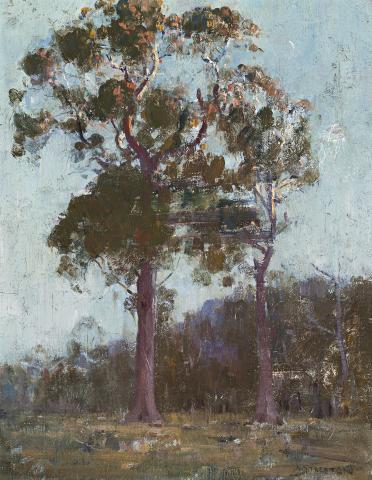EVENING, c.1927
ARTHUR STREETON
oil on canvas
46.0 x 36.0 cm
signed lower right: A. STREETON
Private collection, Melbourne
Thence by descent
Leonard Joel, Melbourne, 14 November 2000, lot 63 (as ‘Blue Gums’)
Gould collection, Melbourne
possibly: Exhibition of Paintings by Arthur Streeton, Fine Art Society Galleries, Melbourne, 15 – 27 March 1928, cat. 19
Director’s Choice 2005, Gould Galleries, Melbourne, 16 February 13 March 2005, and Gould Galleries, Sydney, 18 March – 24 April 2005, cat. 6 (illus. in exhibition catalogue)
The Director’s Choice 2012, Gould Galleries, Melbourne, 19 July – 31 August 2012, cat. 5 (illus. in exhibition catalogue)
possibly: Streeton, A., The Arthur Streeton Catalogue, Melbourne, 1935, cat. 930
The spontaneity with which Arthur Streeton painted the Australian landscape is contagious, drawing the viewer not only into the subject itself, but also enabling a sharing of the artist’s own enthusiastic response. In Evening, 1927, painted near Olinda, this can be felt through the liveliness of the brush strokes, a subtle vigour that translates through the colours and forms into the very being of the painting. The paint almost dances across the picture’s surface, inviting participation in a moment of shared involvement. Poised between day and night and bathed in its gentle atmosphere, the two gums of Evening incline towards silhouette, while the upper branches sparkle with the touches of the light of departing day. When shown in his 1928 solo exhibition at Melbourne’s Fine Art Society Galleries, the critic for The Argus enthused about Streeton’s ability ‘to create an illusion of the golden light of the Australian landscape’.1 Noting the ‘scheme of gold and blue, [as] a favourite one of the artist’, the writer singled out a related painting – ‘Effective painting is displayed in the boldly contrasted mountain study “Sassafras”, in which the rich golden sunlight catches the trees here and there’. It was the writer for The Age, however, who noted a ‘robustness’ in his landscapes, a quality found in Streeton’s overall handling of Evening, and adding to the very grandeur of the gums as they dominate the composition.2
The gum tree is a signature feature of Streeton’s art. In 1890 it towers elegantly above the young lovers embraced in the twilight of ‘Above us the great blue sky’, or singularly fills the sky in The Selector’s Hut: Whelan on the Log, both works being in the collection of the National Gallery of Australia, Canberra. The gum populates the heroic panoramas of gold and blue as in Land of the Golden Fleece, 1926, in the National Gallery of Victoria, Melbourne, or, when silhouetted against the blue waters of Sydney Harbour, creates a focal point as in The Harbour from Kurraba (1926 – 27) in the National Gallery of Australia’s collection. The motif of woodcutter by the fallen and the lone standing trees, as in Whelan on his log, is revisited in Last of the Messmates listed, together with Evening, among his paintings for 1927 in Streeton’s 1935 catalogue of his works. The contrast between the living and the fallen giant is increased by the sharp angle of their vertical and the horizontal presence. Later paintings, as The Vanishing Forest, 1934 (private collection) and A Mountain Side, 1935 (in the collection of the Westpac Banking Corporation), record Streeton’s ongoing concern about the destruction of the forests of the Dandenong ranges where he lived … of a loved and endangered national symbol.
1. ‘Mr. Streeton’s Landscapes’, The Argus, Melbourne, 15 March 1928, p. 13
2. ‘The Art of Arthur Streeton’, Age, Melbourne, 15 March 1928, p. 11
DAVID THOMAS
